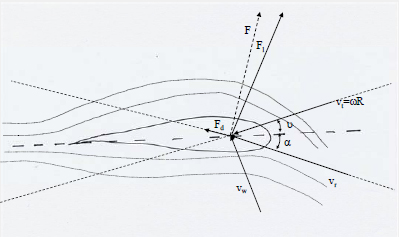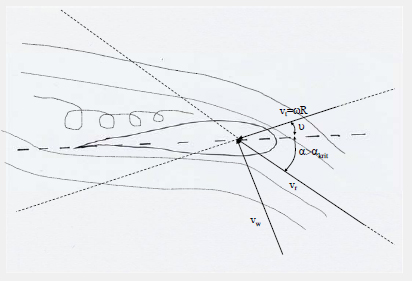Knowledge fuels change - Support energypedia!
For over 10 years, energypedia has been connecting energy experts around the world — helping them share knowledge, learn from each other, and accelerate the global energy transition.
Today, we ask for your support to keep this platform free and accessible to all.
Even a small contribution makes a big difference! If just 10–20% of our 60,000+ monthly visitors donated the equivalent of a cup of coffee — €5 — Energypedia would be fully funded for a whole year.
Is the knowledge you’ve gained through Energypedia this year worth €5 or more?
Your donation keeps the platform running, helps us create new knowledge products, and contributes directly to achieving SDG 7.
Thank you for your support, your donation, big or small, truly matters!
Difference between revisions of "Wind Turbine Technology"
***** (***** | *****) (Created page with "== Wind turbine control concepts<br> == === Aerodynamics<br> === === frame|center|Aerodynamics of a wind turbine bladeStall<br> ...") |
***** (***** | *****) |
||
| Line 1: | Line 1: | ||
| − | == Wind turbine control concepts<br> == | + | == Wind turbine control concepts<br> == |
| − | === Aerodynamics<br> === | + | === Aerodynamics<br> === |
| + | === [[Image:Wind turbine blade aerodynamics.jpg|frame|center|Aerodynamics of a wind turbine blade]]Stall<br> === | ||
| + | [[Image:Wind turbine blade aerodynamics - stall control.jpg|frame|center|Wind turbine blade aerodynamics - stall control.jpg]]Stall Control:<br>– Passive Stall:<br>Power of the wind turbine is limited by the aerodynamic characteristics<br>of the turbine.<br>– Active stall:<br>Power of the wind turbine is limited additionally by decreasing the pitch<br>angle (increasing the inflow angle ).<br> | ||
| − | === | + | === Pitch<br> === |
| − | [[Image: | + | [[Image:Wind turbine blade aerodynamics - pitching.jpg|frame|center|Aerodynamics at a wind turbine blade during control through pitching]]Pitch Control:<br>– Power of the wind turbine is limited by increasing the pitch angle<br>(decreasing the inflow angle <math>\alpha</math>)<br> |
| − | == | + | == Wind turbine operation<br> == |
| − | + | === Operation of Fix Speed Wind Turbine (passive stall)<br> === | |
| − | + | • Start up (with open breaker) if wind speed > cut-in wind speed<br>• Close breaker<br>• Operation at constant blade angle over the whole wind speed range<br>• In case of large wind speeds: Power limited by aerodynamic profile.<br> | |
| − | + | <br> | |
| − | + | === Operation of Variable Speed Wind-Turbines<br> === | |
| − | + | Start up (with open breaker) if wind speed > cut-in wi | |
| − | + | [[Image:Typical power curves of wind turbines.jpg|frame|right|Typical power curves of wind turbines.jpg]] | |
| − | + | nd speed<br>• Close breaker<br> | |
| + | |||
| + | |||
| + | |||
| + | |||
| + | |||
| + | • Below rated wind-speed<br>– Maximum power coefficient (Max. Power Tracking)<br> | ||
| + | |||
| + | |||
| + | |||
| + | |||
| + | |||
| + | – Evt: Speed Limitation<br>• Above rated wind-speed:<br>– P=Pr<br>ated (Limited by power electronics converter)<br>– Pitching | ||
• Advantages of variable speed operation:<br>– Lower cut-in wind speeds<br>– Higher efficiency, especially at low wind speeds<br>– Lower power variations (compared to fixed speed turbines)<br>• Disadvantage: More expensive!<br> | • Advantages of variable speed operation:<br>– Lower cut-in wind speeds<br>– Higher efficiency, especially at low wind speeds<br>– Lower power variations (compared to fixed speed turbines)<br>• Disadvantage: More expensive!<br> | ||
| Line 29: | Line 43: | ||
| − | [[Image: | + | |
| + | |||
| + | == Generator concepts<br> == | ||
| + | |||
| + | === Fixed Speed Induction Generator<br> === | ||
| + | |||
| + | [[Image:Fixed_speed_induction_generator.jpg|frame|center]]Only fix speed operation possible (stall control required)<br>• Reactive power compensation required<br>• No reactive power control capability. Additional devices required:<br>– TSCs (Thyristor switched capacitors)<br>– STATCOMs<br>• Risk of dynamic voltage collapse<br>GTZ Expert Workshop 2010: Grid and System Integration of Wind Energy, 22/23.11.2010, Berlin/Germany<br>y g p<br>– > Typically, wind generators based on induction generators are asked to<br>disconnect in case of voltage dips<br> | ||
| + | |||
| + | === Induction Generator with Variable Rotor Resistance<br> === | ||
| + | |||
| + | [[Image:Induction_Generator_with_Variable_Rotor_Resistance.jpg|frame|center]]Simple concept for variable speed operation.<br>• Reactive power compensation required.<br>• No reactive power control capability. Additional devices required:<br>– TSCs (Thyristor switched capacitors)<br>– STATCOMs<br>• Limited LVRT capability. Dynamic voltage collapse problems have to<br>GTZ Expert Workshop 2010: Grid and System Integration of Wind Energy, 22/23.11.2010, Berlin/Germany<br>be mitigated by:<br>– Fast increase of rotor resistance during faults<br>– Additional reactive power compensation devices (typically TSCs)<br><br> | ||
Revision as of 15:50, 12 July 2011
Wind turbine control concepts
Aerodynamics
Stall
Stall Control:
– Passive Stall:
Power of the wind turbine is limited by the aerodynamic characteristics
of the turbine.
– Active stall:
Power of the wind turbine is limited additionally by decreasing the pitch
angle (increasing the inflow angle ).
Pitch
Pitch Control:
– Power of the wind turbine is limited by increasing the pitch angle
(decreasing the inflow angle )
Wind turbine operation
Operation of Fix Speed Wind Turbine (passive stall)
• Start up (with open breaker) if wind speed > cut-in wind speed
• Close breaker
• Operation at constant blade angle over the whole wind speed range
• In case of large wind speeds: Power limited by aerodynamic profile.
Operation of Variable Speed Wind-Turbines
Start up (with open breaker) if wind speed > cut-in wi
nd speed
• Close breaker
• Below rated wind-speed
– Maximum power coefficient (Max. Power Tracking)
– Evt: Speed Limitation
• Above rated wind-speed:
– P=Pr
ated (Limited by power electronics converter)
– Pitching
• Advantages of variable speed operation:
– Lower cut-in wind speeds
– Higher efficiency, especially at low wind speeds
– Lower power variations (compared to fixed speed turbines)
• Disadvantage: More expensive!
Generator concepts
Fixed Speed Induction Generator
Only fix speed operation possible (stall control required)
• Reactive power compensation required
• No reactive power control capability. Additional devices required:
– TSCs (Thyristor switched capacitors)
– STATCOMs
• Risk of dynamic voltage collapse
GTZ Expert Workshop 2010: Grid and System Integration of Wind Energy, 22/23.11.2010, Berlin/Germany
y g p
– > Typically, wind generators based on induction generators are asked to
disconnect in case of voltage dips
Induction Generator with Variable Rotor Resistance
Simple concept for variable speed operation.
• Reactive power compensation required.
• No reactive power control capability. Additional devices required:
– TSCs (Thyristor switched capacitors)
– STATCOMs
• Limited LVRT capability. Dynamic voltage collapse problems have to
GTZ Expert Workshop 2010: Grid and System Integration of Wind Energy, 22/23.11.2010, Berlin/Germany
be mitigated by:
– Fast increase of rotor resistance during faults
– Additional reactive power compensation devices (typically TSCs)


























